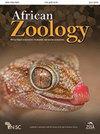A Review of Marine Invertebrates Used as Fishing Baits and the Implications for National and Regional Management in the Western Indian Ocean
IF 0.5
4区 生物学
Q4 ZOOLOGY
引用次数: 0
Abstract
In the Western Indian Ocean (WIO), more than 76 records from peer-reviewed and grey literature identified approximately 60 invertebrate taxa harvested for bait and food. The most diverse phyla were Mollusca, followed by Arthropoda and Annelida, with few records of Porifera, Nemertea and Echinodermata. Importance of each phylum differs according to country, with arthropods (Upogebia africana and Kraussillichirus kraussi), and annelids (Marphysa mossambica) being most important in South Africa and Kenya, respectively. Of the taxa utilised, only 42 are reliably identified to species level, suggesting that the diversity of species utilised in the region is greatly underestimated. Most of the data on biology and exploitation were for species from South Africa. Less data were available from Kenya with minimal to none being available from the remaining WIO countries. This limits the understanding of biology and trends in exploitation of most bait taxa, and consequently information required for developing national and regional management policies. Bait management guidelines are available only for South Africa, but require updating in view of changes in use of bait resources. We recommend the development of coordinated multidisciplinary, multicountry research aimed at increasing data and information to feed into policy development and support national and regional bait resource management.西印度洋用作鱼饵的海洋无脊椎动物及其对国家和地区管理的影响
在西印度洋(WIO),来自同行评议的76多条记录和灰色文献确定了大约60个无脊椎动物分类群,这些分类群被用作诱饵和食物。软体动物种类最多,节肢动物次之,环节动物次之,孔虫目、刺皮目及刺皮目记录较少。每个门的重要性因国家而异,节肢动物(Upogebia africana和krausssilichirus kraussi)和环节动物(Marphysa mossambica)分别在南非和肯尼亚最重要。在利用的分类群中,只有42个被可靠地鉴定到物种水平,表明该地区利用的物种多样性被严重低估。大多数关于生物学和开发的数据都是来自南非的物种。从肯尼亚获得的数据较少,从其他世界卫生组织国家获得的数据很少甚至没有。这限制了对大多数诱饵分类群的生物学和开发趋势的理解,从而限制了制定国家和区域管理政策所需的信息。诱饵管理准则仅适用于南非,但鉴于诱饵资源使用的变化,需要加以更新。我们建议开展协调的多学科多国研究,以增加数据和信息,为政策制定提供依据,并支持国家和区域诱饵资源管理。
本文章由计算机程序翻译,如有差异,请以英文原文为准。
求助全文
约1分钟内获得全文
求助全文
来源期刊

African Zoology
生物-动物学
CiteScore
2.60
自引率
9.10%
发文量
18
审稿时长
>12 weeks
期刊介绍:
African Zoology , a peer-reviewed research journal, publishes original scientific contributions and critical reviews that focus principally on African fauna in terrestrial, freshwater, and marine ecosystems. Research from other regions that advances practical and theoretical aspects of zoology will be considered. Rigorous question-driven research in all aspects of zoology will take precedence over descriptive research. The Journal publishes full-length papers, critical reviews, short communications, letters to the editors as well as book reviews. Contributions based on purely observational, descriptive or anecdotal data will not be considered.
The Journal is produced by NISC in association with the Zoological Society of South Africa (ZSSA). Acceptance of papers is the responsibility of the Editors-in-Chief in consultation with the Editors and members of the Editorial Advisory Board. All views expressed are those of the author and not necessarily those of the Editors or the Department.
 求助内容:
求助内容: 应助结果提醒方式:
应助结果提醒方式:


